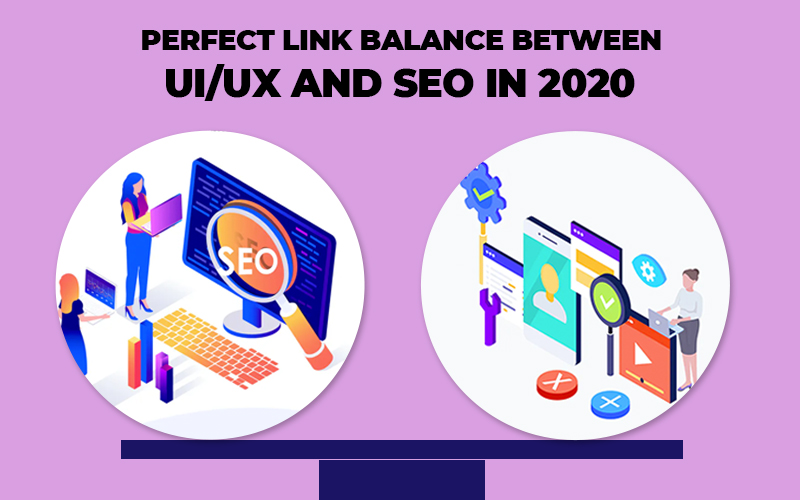Can any industry intent on un-defining itself? You must have come across several articles stating the irrelevance of UX. With this strive, loads and loads of myths are seen spreading like a fire, alarming several search engine based organizations, as well as common website proprietors. So, in this article we explain the amicable connection between UX and SEO.
UX and SEO
User experience is more progressively systematic and specialized. The process surely provides relevant and deeply meaningful experiences to your audience. The way into its prosperity is information, research, and client knowledge.
Search Engine Optimization (SEO) is how you can build the perceivability of your site on web indexes like Google, Yahoo, and Bing! Search engine optimization is fundamentally used to move towards its audiences with content they can expect on the site page. By implementing off-page and on-page SEO strategies you can control your online presence.
So you see UX and SEO seem like two parallel rail tracks that might never meet or coincide.
Let’s get down to the point where UI/UX design fits into SEO. Now many of you have this misconception stating SEO involves only link building and stuffing relevant keywords in the content. But SEO, in general, involves a lot more! And that’s when elements of user experience (UX) can be successfully rolled into SEO practices.
• Having a mobile-friendly site
• A website that features quality content that engages users and encourages them to stay
• A website which is quick to load and easy to navigate
According to Google, everything keeps on updating these days so that the end-users are provided with the best possible results more specifically user-focused and user-friendly ones. It may also interest you to know that recent algorithm updates have shown just how critical UX has become. And somehow SEO and UX do share something in common.
SEO is never again confined to exclusively positioning for search terms; it looks to furnish searchers with data that answers their queries. Furthermore, that is the point at which UX and SEO meet. Both offer the objective of helping clients by giving them the required information. Search engine optimization will lead an individual to the substance they need, and the UX answers their questions once a client winds up on the website page.
UX does affect SEO, but the question is how?
#1 Give a satisfying answer–
When your audiences receive a satisfying answer which massively helps their quest for answers – or maybe even ends it because you’ve answered their question.
So basically, you need to understand what exactly their search intent is. It is the reason behind an inquiry – for what reason is this individual looking? What precisely are they searching for? Flopping in these means implies you will come up short at everything – conveying an extraordinary client experience, driving natural traffic, and making deals.
So what you have to do next is make the appropriate response (as substance) regardless of whether it’s concerning the content, pictures, recordings, introductions, webcasts, and accommodating devices that can assume a significant job as well. Make sure your answer is familiar with Informational, Navigational, Commercial, and Transactional areas.
A satisfying answer doesn’t need to be long! I mean writing a 3000-word article is not always acceptable. Chances are, that you might miss the search intent. So what needs to be done is-
• Understand the client’s pursuit aim
• Create content that truly responds to their inquiry, utilizing the substance type(s) that are probably going to help the most.
• Make the article as long or short as it is required to be.
#2 Queries
You comprehend what questions you need to rank for. You’ve made the best substance out there, it’s beginning to rank, yet is it winning the client’s snaps? Are your bits connecting with, and do they stick out?
Don’t you think that conveying incredible client experience is important? After all, there is no point if the visitor doesn’t click on your piece at all.
But the question is how to get those clicks? Keep a few things in mind –
• Title- Have an optimal title length and make sure that it contains your primary keyword
• URL- Have an optimal length URL which is user-friendly
• Description- Have an optimal length description and make sure it contains your keywords and gives your user a brief idea of your content
#3 Winning the user’s trust
As of now, you have the snaps, clients have arrived on your page. But hang in there for a moment, have you earned their trust? Trust and believability are quite critical when thinking of variables. So what should be done is:
• Serve your pages over a protected association (HTTPS).
• Have surveys and tributes.
• Back up your cases with definitive sources, and have specialists review your articles.
• Try answering their question as soon as possible, I mean nobody likes to wait. Just make sure that your page needs to be loaded pretty fast.
• Use a Content Delivery Network (CDN).
• Use caching and file compression. Minify your Javascript and CSS.
• Avoid render-blocking resources.
• Lazy-load your images and serve responsive images.
• Use image formats smartly (notably WebP and SVG).
Time to kill two birds in one arrow – Improve UX and SEO, BOTH
1. Focus on the bounce rate-
Abandoning websites has been pretty common these days. One of the normal reasons may include, catchphrases you’re positioning for may not identify with your webpage’s substance, your site might be delayed to load, or website guests may encounter blunders when they land on your website. With regards to the bounce rate, the lower the rate the better. So as an answer one can :
• Create different presentation pages for natural traffic to land
• Write top-notch content with pertinent watchwords
• Craft an important Meta description that attracts individuals to your site.
• Focus on the content association, utilization of whitespace, huge text styles, shot records, and great shading contrast
2. Use Proper Headings-
Consider headings as a tour guide that has the potential to control your visitors through your substance. Also, web crawlers comprehend the reason for your site. Truth be told, making a fitting heading can make it simpler for both site guests and web crawlers with the goal that they can perceive what your substance is about. Appropriate headings make an intelligent chain of command, sort out musings, etc. Along these lines, individuals can comprehend the essential focal point of your page and crawlers can file your site under the correct classifications in list items.
3. Offer seamless navigation-
Last but certainly not the least, slow navigation inversely affects UX design and SEO. When it comes to a navigation menu-
• Avoid complex, staggered, or befuddling all the menu elements
• Make sure your versatile site’s route is anything but difficult to utilize
• Include a route menu on all website pages. Individuals won’t generally arrive on your site’s landing page
• Consider making your menu clingy on your work area site so it follows site guests as they scroll
• Be illustrative, however clear about where everything drives site guests
• Add an inquiry bar so individuals can type what they’re searching for on your site
To sum it up, it’s critical to take a note on how UX/UI design immensely improves SEO execution. More or less, executing a solid UX plan with your SEO information will drive an enormous volume of visitors who are keen to know more about business.




